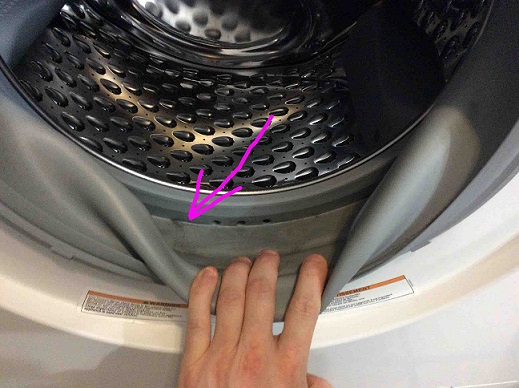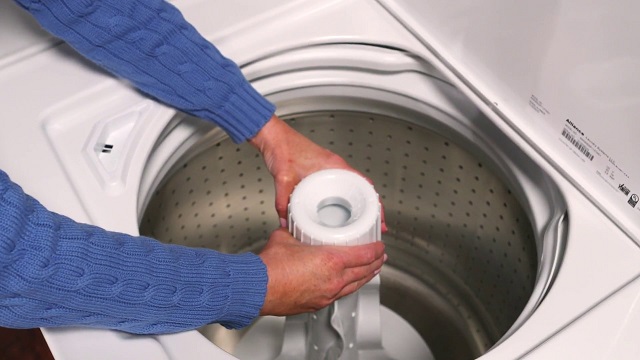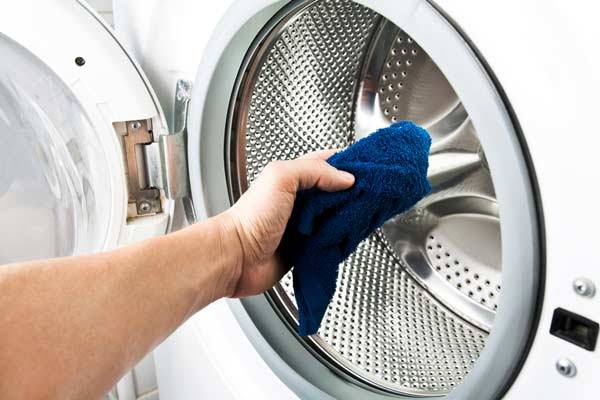Mould is the main reason why your washing machine smells weird like rotten eggs.
If not properly maintained or not cleaned regularly, mould can form on the gasket seal and behind the drum. And moreover, front-load devices are prone to frequent mould contamination because of their tendency to retain residual moisture inside the unit.
Fortunately, you don’t need professional help to get rid of mould and mildew from the washing machine. Though it may be a little bit tough to deal with mould on the gasket, it is not impossible.
In this article, we have provided clear and simple instructions, following which you can easily and quickly make the washing machine mildew-free.
Check Also For
Different Ways to Get Rid of Mould in Washing Machine
Before we get started, make sure you have a commercial mould cleaner at home. If you do not have or do not want to use the same, you can always prepare one.
Here are the several ways you can create a homemade cleaning mixture:
Cleaning Solution 1:
We all know the efficacy of hydrogen peroxide and lemon juice. They are effective natural cleaners to seize mould and further obstruct its growth.
This is all you need
- Water – 2 Cups
- Hydrogen Peroxide – Half Cup
- Lemon Juice – Quarter Cup
Cleaning Solution 2:
If you do not have hydrogen peroxide available at home, you can always use white vinegar. It is not only a perfect alternative but also an all-round cleaning solution.
This is all you need
- Water – 2 Cups
- Distilled White Vinegar – Half Cup
- Lemon Juice – Quarter Cup
Cleaning Solution 3:
You can also prepare a cleaning mixture using vinegar and water alone. This solution will suffice if the mould growth is lesser and thin.
This is all you need
- Water – 4 Parts
- Vinegar – 1 Part
Cleaning Solution 4:
If you feel that the cleaning solutions mentioned above do not play the trick, you can use bleach.
This is all you need
- Water – 4 Parts
- Bleach – 1 Part
Cleaning Process
Now that you are ready with the cleaning solution, it is time to get started with the cleaning process. Follow the below step-by-step process:
Step 1: Cleaning Gasket
Since a gasket is a prime reason for mould build-up, start cleaning the gasket first.
This is all you need
- Cleaning Solution
- Spray Bottle
- Towel or Cloth
- Old Toothbrush
- Rubber Gloves and Mask
Instructions to follow:
- Take your preferred cleaning solution from the list, as mentioned above, and add it to a spray bottle.
- Spray the solution over the mould present on the door gasket.
- After spraying, take a towel or cloth and clean the gasket.
- For stubborn spots, allow the solution to sit for a few minutes and then clean it with an old toothbrush.
Note: Make sure you are wearing rubber gloves and a mask to protect your hands and avoid inhaling the mildew, respectively.
Step 2: Clean Dispensers
After you finished cleaning the gasket, move to the dispensers.
This is all you need
- Cleaning Solution
- Spray Bottle
- Pipe or Bottle Cleaner
Instructions to follow:
- Remove the detergent dispensers from the washing machine.
- Take your preferred cleaning solution from the list, as mentioned above, and add it to a spray bottle.
- Spray the solution over the dispensers and scrub them properly.
- If you cannot remove them, use a pipe or bottle cleaner to give the best cleaning by reaching into the crevices.
Step 3: Clean the Drum
Let us now come to the drum. As the door gasket and soap dispensers are clean, we will run the machine through a series of three cycles in this step.
This is all you need
- Bleach
- Vinegar
- Water
Instructions to follow:
For the First Cycle
- Pour about one to two cups of bleach into the drum.
- Pour some quantity of it in the soap dispensers, as well.
- Now, adjust the water temperature settings on the machine to hot and choose the longest cycle.
- During this process, the mould and the mildew present in the dispenser and also the tub of your washer get killed.
For the Second Cycle
Now that you finished the first cycle, time to let your washer run through the second cycle.
Use vinegar instead of bleach and repeat the process as in the first cycle. Doing this deodorizes the machine.
For the Third Cycle
After the second cycle, run your appliance through the last and third cycle of water to flush it.
Let us take a look at some of the maintenance tips to follow regularly:
- Use a specially formulated washing machine cleaner to clean the device regularly once every month.
- If you do not have a cleaner, you can include a half cup of bleach in the normal hot wash cycle for cleaning.
- For the washers that come with a sanitary wash cycle, make sure you use only bleach for a deep clean and maintenance.
Despite all these hacks, if the mouldy smell persists, then there is a possibility that the mildew is likely growing behind the drum. Seek the help of a professional who can diagnose and fix this issue at the earliest.
What Are the Ways to Prevent Mould Growth in Your Washing Machine?
While removing mould is essential, preventing it from growing is equally essential. Be it a top load or a front-load model, you can easily avoid the mildew build-up. All you have to do is just follow the below tips religiously, and you will not notice any trace of the mould in your washing machine.
1. Use Only the Right Detergent
Most washers from popular brands are HE (High-Efficiency) models. Make sure you use only HE detergents for such units and not some ordinary products. Using regular detergents or liquid detergents may cause over sudsing that may eventually lead to mould growth. Also, ensure that you are using an adequate amount of detergent, as recommended by the manufacturer in the manual.
2. Leave the Lid Open
Never close the washing machine door immediately after using it. Allow the appliance to dry completely by keeping the door open to prevent the mould growth.
3. Remove Loads Promptly
What most of us tend to do is that we do not remove the wet clothes from the washing machine immediately after the laundry. This will lead to moisture and mould build-up inside. To prevent the same, remove the load soon after the appliance finishes washing. This way, you can also prevent the musty smell on your clothes.
4. Clean the Gasket
Clean the door gasket of your washing machine regularly using a mould cleaner, at least weekly once. This eliminates moisture and avoids soap residue that leads to mould growth.
This is how you do:
- Take an old towel and wipe around and beneath the door gasket of your washing machine.
- You should also clean up the inside of the door.
5. Use a Dehumidifier
The area where you position your washing machine is also crucial. Did you know that outside humidity can be a contributing factor to the mould growth inside the washer? Hence, make sure the place is not humid and does not have a water problem. In such a case, use a dehumidifier insider the room.
6. Avoid Fabric Softener
We all add liquid fabric softeners to the washing machine to keep the fabrics soft. However, this can leave residue behind in the washer drum leading to mould. To prevent the same, avoid using a fabric softener. Instead, try using dryer sheets or balls to soften your clothes.
7. Use Bleach
When washing dirty clothes like shower curtains, muddy towels or gardening clothes, etc., make sure you add a small amount of bleach to the washing machine during the wash cycle.
8. Wipe it down
Once you finish using the washing machine for that day, allow the device to dry by leaving the door open. Before you close it, make sure you wipe all the parts of the washer, including the gasket, dispensers, drum, and door using an old towel.
9. Use Vinegar
As mentioned earlier in the article, do not use fabric softeners to soften your clothes. Instead, we recommend using vinegar as it will not leave any residue in your washing machine that may lead to mould growth.
10. Check Hose
Check the washing machine hoses very often to identify any signs of wear and tear. Also, ensure the attachment is firm, and there is no loose connection. If required, replace the hose once every three to four years. When you fail to do so, it may foster the growth of mould inside and may hamper the performance of the device, eventually damaging it.
11. Washer Cleaning
Cleaning your washing machine at least once every month is essential to prevent the mould build-up. Furthermore, it also ensures the peak performance of the appliance.
Some Frequently Asked Questions:
All washing machines of any model (top load or front load) will have the mould problem. However, it is more persistently seen in front load models because of the airtight doors with a gasket seal. Other areas of the washer are prone to mildew other than the gasket, like the detergent dispensers, the top area of the drum, inside the drum, and the door of the machine. Of them all, the rubber seal is highly susceptible to mould growth as it traps moisture.
You should always keep the washing machine door open when you are not using it, as it facilitates ventilation to the appliance. After every wash, make sure to keep the lid open to allow the moisture to escape and further prevent mould from growing inside the drum of the washer.
Conclusion
I hope you have now got a clear idea of the preventive measures you should take to avoid mildew build-up in your washing machine. Follow the above tips right away if you notice any stinky odour from your appliance or mould growth. Save your clothes and your family from mould-related health issues.
If you tried these above hacks, write to us in the comments section below and let us know your response. If you have not tried yet, do it immediately.
If you need more information on the same, do not hesitate to write to us. We would be happy to help you. Stay Healthy and Stay Safe!




